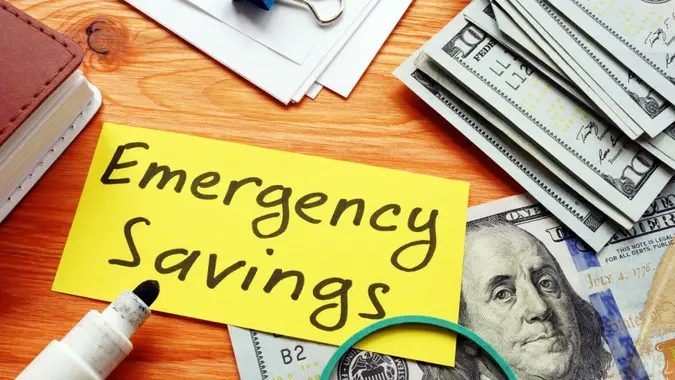100 Envelope Challenge: TikTok’s Viral Way To Save $5,000 Fast

Commitment to Our Readers
GOBankingRates' editorial team is committed to bringing you unbiased reviews and information. We use data-driven methodologies to evaluate financial products and services - our reviews and ratings are not influenced by advertisers. You can read more about our editorial guidelines and our products and services review methodology.

20 Years
Helping You Live Richer

Reviewed
by Experts

Trusted by
Millions of Readers
Saving money doesn’t have to be boring. The viral 100 Envelope Challenge circulating on TikTok has become a low-pressure way to save about $5,000 in only 100 days — one envelope at a time. Here’s how it works.
What Is the 100 Envelope Challenge?
The 100 envelope challenge is a motivational way to save just over $5,000 in 100 days. This savings tool is a fun way to put some extra cash aside for future financial goals. Not many of us have thousands of dollars lying around, so the 100-day money challenge adds a twist to the concept of saving money.
How The 100 Envelope Challenge Works: Step-by-Step
How To Save $5,000 in 100 Days
- Get 100 empty envelopes. Use an envelope size that cash bills can easily fit into. Coins are fine to use, but they can be a hassle to keep in the envelopes.
- Number each envelope from 1 to 100. Keep them in order for now; you will shuffle the order in the fourth step.
- Store your envelopes in a container. Choose a container that works easiest for you. It can be a box, a basket or something else. An empty shoebox is a good option.
- Shuffle the envelopes in random order. The idea is to be surprised by the amount you save each day.
- Pick an envelope at random each day. Without looking, take an envelope from the box. Try not to cheat and select an envelope with the amount you think that you can safely save that day.
- Insert the day’s money amount in the envelope. Whatever number is on the envelope you pick, place that cash value inside. For example, if you pull the envelope with the number 50 on it, put $50 inside that envelope and seal it.
- Put the filled envelope aside. You can place the filled and sealed envelopes in the back of the box or in a separate secure location until the 100-day money challenge is complete. If you use the same box, try putting a divider between the empty and filled envelopes or placing the filled envelopes upside down.
- Track your savings progress. To motivate yourself not to quit the challenge, consider keeping a ledger of your savings either on paper or by using a spreadsheet or a free mobile app.
- Finish the challenge. When your box of envelopes is either empty or replaced with cash-filled envelopes, you will have saved $5,050 and completed the 100 envelope challenge.
Pros and Cons of the 100 Envelope Challenge
Although fun, the 100-day money challenge has its pros and cons. Here are a few to consider before deciding to participate in this TikTok spinoff of the envelope method of budgeting.
Pros
- The challenge is an easy way to save cash quickly.
- If your financial situation changes, you can stop the challenge and restart it when you can.
- It can help you create a money-saving habit.
Cons
- It takes some motivation to finish the challenge.
- On some days, you may not have the cash to save.
- Having thousands of dollars in cash lying around could be risky.
100 Envelope Challenge vs. Other Savings Challenges
Want to know more about other savings challenges? Here’s an overview.
100 Envelope Challenge vs. 52-Week Challenge
The 52-week challenge encourages you to save an increasing amount every week, adding up to an entire year’s worth of saving. You’ll set aside $1 in the first week, $2 in the second week and so on. At the end of 52 weeks, you’ll have $1,378.
Pros:
- Easy steps to follow
- Gradual savings may be more manageable
- Wil work well for those who receive regular income
Cons:
- Saving more as the weeks progress can be challenging
- 52 weeks require a longer commitment
- Savings are less than the 100 Envelope Challenge
100 Envelope Challenge vs. No-Spend Challenge
With the No-Spend Challenge, you designate a period where you spend money on nothing but the bare essentials. Those necessary items might include groceries or paying bills. Most people decide to do the challenge for a month, but you can increase or decrease the length if that suits your needs better.
Pros:
- You have a chance to identify nonessentials and cut them out.
- Encourages mindful spending
- The savings can be tremendous, depending on your spending habits before the challenge.
Cons:
- Requires a high degree of self-control
- Not sustainable over a long period
- Can feel restrictive
100 Envelope Challenge vs. Round-Up Apps
A round-up app will round up any purchases to the nearest dollar and allow you to pocket the difference. So, for example, if you purchase something worth $4.75, the app will round it to $5, saving you 25 cents.
Pros:
- Automated savings requires little to no effort
- Small amounts will add up over time
- May be best for those looking for a passive savings strategy
Cons:
- Slower than other challenges
- You will need to continuously spend to accumulate savings
- This may not work well for those who like to manage their savings closely.

How Does the 100 Envelope Challenge Work?
Imagine saving $5,000 in only 100 days. It’s called a challenge, but the process is quite simple. You get 100 empty envelopes and write the numbers 1 to 100 on them. Then each day, for 100 days, randomly choose an envelope. Whatever number is on the front of the envelope you select for a given day, you put that amount of money into the envelope.
Using Digital Envelopes
Instead of using 100 physical envelopes, a more practical way of doing the 100-day money challenge is to do it digitally. Here’s how:
- Download a 100 envelope challenge printable tracker with the numbers 1 to 100 on it.
- Use an online random number generator to pick the daily random numbers that equate to the amount of money to save.
- Open a separate savings account to manually deposit or transfer the money during the 100 envelope challenge.
How To Customize the 100 Envelope Challenge
The 100 envelope challenge requires a significant amount of disposable income, especially in the later weeks. However, you can customize the program for more realistic savings goals.
Start with a goal and a timeline — say $1,200 in six months. Then decide how to break that down. Saving a consistent amount each time and coordinating the savings schedule with your paychecks might be the easiest way to go. Here’s what that might look like:
| Goal | Timeline | Envelope Count | Savings Per Envelope |
|---|---|---|---|
| $1,200 | 6 months | 24 envelopes | $50 each week |
| $2,000 | 4 months | 40 envelopes | $50 every three days |
| $2,600 | 1 year | 26 envelopes | $100 biweekly |
Alternatively, you can keep the element of fun and surprise by assigning each envelope a different dollar value. There’s no need to number them consecutively — just make sure they add up to the goal amount.
100 Envelope Challenge Not for You? Here Are Alternatives
Save $5,000 in 3 Months
The 52-week money challenge may take too long for your standards, so if you want to boost your savings in three months, you have other options. By following these tips to get your finances on track, you can set yourself up to save $5,000 in three months.
Pay Down Debt
Before you can start saving money, you must first pay off your debts. Here are two methods you can use:
- Snowball method: The debt snowball method focuses on paying off your smallest debts first. You would do this while simultaneously making minimum payments on other debts. Once the smallest debt is paid off, you move to the next smallest debt, then on to the larger ones, and it snowballs from there until you have crossed all payments off of your list.
- Avalanche method: The debt avalanche method focuses on paying off your debts in order of the highest interest rate to the lowest interest rate. This can feel like a lot at once, but it does save you money in the long run.
Evaluate and Limit Spending
Cutting down on unnecessary spending will help build your savings quickly. Here are some ways to do so:
- Do your own hair or nails instead of going to salons.
- Cancel your gym membership and work out at home.
- Cook at home and meal prep instead of eating out or paying for meal delivery services.
- Switch from name brands to generics.
- Rotate streaming subscriptions instead of subscribing to multiple services at the same time.
- Call your cable/internet and wireless providers to see if you can negotiate a better deal.
Lifestyle Edits
Changes to how you make and spend your money could mean bigger savings in the future. Here are a few examples:
- Sell your car and take public transportation.
- Move to a less expensive neighborhood.
- Get a roommate.
- Get a side hustle.
- Ask for a raise — or better yet, trade up to a higher-paying job.
Final Take To GO
If you have tried other ways of saving money and haven’t been successful, then the 100 envelope challenge might be the perfect tool to get you started. Following the challenge as prescribed can jump-start your savings and get you into the habit of saving regularly.
100 Envelope Challenge FAQ
Here are more answers to frequently asked questions about the 100 envelope challenge and saving money.- How much money do you get from the 100 envelope challenge?
- If you follow the 100 envelope challenge, you can save $5,050 in just over three months.
- How long does it take to do the 100 envelope challenge?
- The 100 envelope challenge takes 100 days to complete, as you'll use one envelope per day.
- How can I save $5,000 in six months with 100 envelopes?
- The standard 100 envelope challenge takes about three months. If you select an envelope every other day instead of every day, you'll stretch it to about six months.
- How can I save $10,000 in six months of envelopes?
- Saving $10,000 in six months essentially doubles the original 100-day challenge, so you would stick to the same savings protocol but do so with 200 envelopes over 200 days.
- Can you skip days in the 100 envelope challenge?
- You can skip days in the 100 envelope challenge if you need to, as the savings strategy is meant to be flexible. Get back on track when it works for your schedule and your cash flow. Ultimately, the key to success will be saving consistently and making up for any skipped days when you can.
- What if I can't afford the higher numbers?
- You can always adjust the savings challenge if you're having difficulty affording the higher numbers. You can number the envelopes smaller, such as from 1 to 50. You can also try drawing out fewer envelopes or adjusting how frequently you're drawing envelopes. If you draw a high number, you can make a plan to split that amount over a period of time.
- What's the best way to store filled envelopes?
- To store your envelopes, you might consider keeping them in:
- A box or another container
- Locked drawer
- Safe
- Wherever you choose, just make sure that your envelopes are clearly labeled and stored in a place that you know will be secure.
- To store your envelopes, you might consider keeping them in:
- Can I do this challenge with a partner?
- You can do the 100 envelope challenge with a partner! It can even help the two of you stay motivated, as you'll have someone going through the motions with you. Here are some tips:
- Share the envelopes
- Set an end goal that will work for both
- Provide support and encouragement so both of you stay on track.
- You can do the 100 envelope challenge with a partner! It can even help the two of you stay motivated, as you'll have someone going through the motions with you. Here are some tips:
Daria Uhlig and Caitlyn Moorhead contributed to the reporting for this article.
Our in-house research team and on-site financial experts work together to create content that’s accurate, impartial, and up to date. We fact-check every single statistic, quote and fact using trusted primary resources to make sure the information we provide is correct. You can learn more about GOBankingRates’ processes and standards in our editorial policy.
 Written by
Written by  Edited by
Edited by 

























